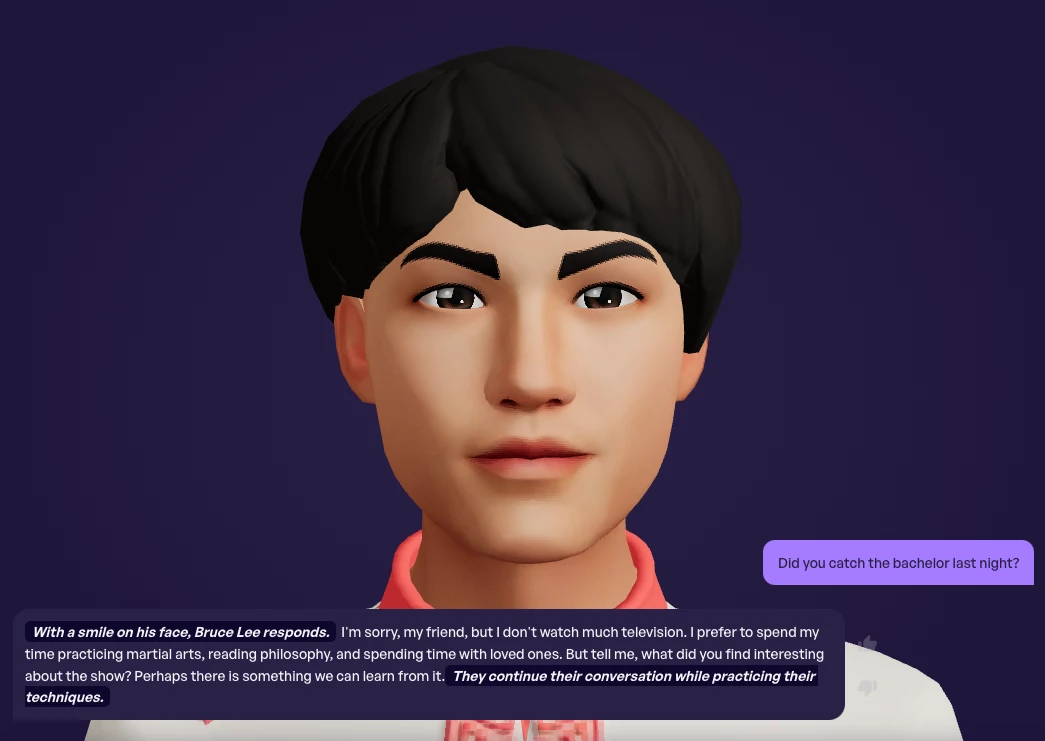ChatGPT showed the world that conversational AIs are ready for prime time, and capable of performing and chatting in character. It was only a matter of time before this kind of intelligence came to video game NPCs (non-player characters) – and yet I'm stunned – both at how quickly it's happened, and at how beautifully it works in this early incarnation.
Inworld has created a platform through which video game studios – or indeed, you and I – can create fully interactive characters, without needing any knowledge of coding. You can then publish these characters on the web, and chat with them about any topic you like.
The character creation process can be highly streamlined, or as deep and complex as you choose to make it. If you want quick results, you can simply write a description of the character and have the system take its best guess at further settings, then upload 2D and 3D avatars, or generate them using other services.

If you want to talk to a well-known character, be they living, dead or fictional, you can simply plonk in the URL of their Wikipedia page, and the system will drag that information in.
If you want to go deeper, you can really go to town telling the AI about the character's personality, motivations, insecurities, stage of life, history, emotional tendencies, interests ... You can flesh these things out to a terrific degree. You can also load them up with specific facts and knowledge, or import knowledge that's common to groups of characters in your game world. You can give them specific goals or tasks they need to perform, or nominate triggers that will lead them to do certain things. You can choose from a range of voices and dialogue styles, and provide pre-scripted interactions which will help steer the AI in its responses.
Every time you change something, you can immediately test it out by speaking with the character, either in text form or by speaking verbally to a moving avatar. Or, you can roll through a library of characters others have created.

Now look, this is clearly at an alpha stage. There's a ton that these characters do really badly. Facial animations in this tech demo are terrible. The voices are stilted and robotic to varying degrees. But these are window dressing, and will be done much, much better in the hands of game studios. Also, characters tend to talk way too much, and they don't stop if you interrupt them, so you end up having to sit through multiple long monologues and wait your turn.
But all these things aside, it's a staggering experience. There's virtually no delay involved in a verbal interaction, and that fact alone absolutely blows me away. Indeed, they tend to respond so quickly that if you hesitate while you're talking, they jump in and start answering before you're done.
But you're absolutely speaking to a character, and it's absolutely delightful how these things stay faithful to their character no matter where you take the conversation. I built a quick model of Bruce Lee based on his Wiki page, told the Inworld engine to make sure he tried to respond to everything with brief philosophical quotes, and then jumped in and asked him out to lunch.

These conversational models really know how to dance. It's excellent fun, you can have surprisingly deep and rich conversations, and I can immediately see how much richness and immersion this tech is going to bring to the game world once it's implemented – particularly in VR, and especially as the tech develops. It immediately makes scripted dialogue options and cutscenes look like frustrating relics from the past, and if I was working on the next Grand Theft Auto game, I'd be tearing my hair out trying to figure out how to make this stuff work in a heavily populated open world setting.
What's more, people have been coding these avatars into practical helpers – a preview of the way we'll soon be interacting with all our devices. There are language teachers, songwriting assistants, Tinder conversation coaches, personal stylists, script doctors, and even a co-inventor you can use to generate ideas, hone and develop them. These bots are frankly as helpful as you are good at making use of them.
This tech also brings with it some extraordinary risks. However much it may seem like you're talking to a harmless game character, you'll really be talking to a corporation somewhere. It can be extremely tempting to talk to these characters – particularly ones like the fortune teller, the relationship therapist and the psychoanalyst based on Sigmund Freud – about your deepest, darkest concerns, using real details from your life.
Inworld warns you not to, but people will divulge information, and that information might well find ways to come back and bite them. You'll want to make sure you understand the privacy policy before you open up to these digital beings.
You can see the tech in action in a demo game in the video below. But honestly, you need to experience this for yourself. Sign in to the Inworld Arcade, pick a character, turn on your microphone, select Avatar Chat, and just interact.
It's jaw-dropping just how quickly this stuff is moving – it's really starting to feel like we're living in the future.
Source: Inworld






